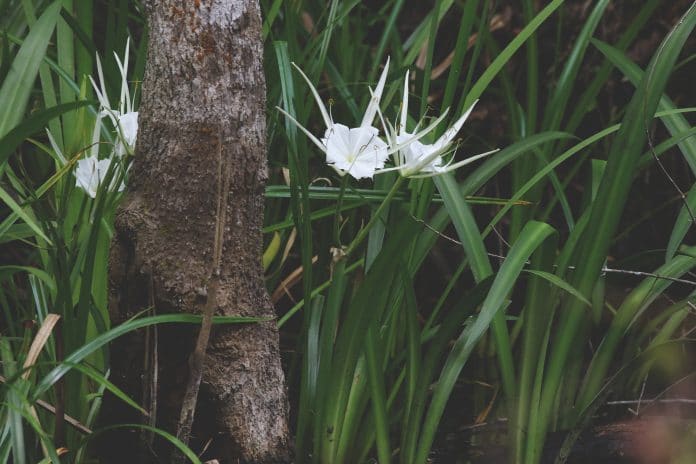As we begin the month of May with a few flowering vines, over the next three weeks blooms will start to fade. Summer wildflowers and orchids that were dormant over the Spring season will begin to emerge. Join us as we take you on our final journey discovering the remaining blooms for the Spring season in Hernando County.
Wild Potato Vine (Ipomoea pandurata)
Wild Potato Vine, also called Man of the Earth, is in the morning glory family. It is not at all related to Dioscorea bulbifer, or Air Potato, which is an invasive exotic vine. Ipomea pandurata is known to grow wild over much of the Eastern and Midwestern United States. It likes moist to somewhat dry areas, such as fields, roadsides, and along railroad tracks. It can become a bit weedy but is not invasive. This native plant provides nectar for many pollinators, including bees with long “tongues” such as digger bees, bumblebees, and long-horned bees. Bats find this flower a lovely treat during anthesis, or when the flower is fully open. Pollinating beetles enjoy the starchy underground tubers.
Tievine (Ipomoea cordatotriloba)
Tievine is another beautiful morning glory. This vine can be found in partly shady areas that have been disturbed. It has beautiful light purple petals, and the flower itself looks like it is divided into five sections by lines. The lines all meet a dark purple star inside the cup of the flower. The perennial vine is fragrant but can get a little weedy in a garden environment. Let it grow in the wild, or in a natural area of your yard. Don’t try to tame the wild nature out of this plant. The birds will thank you, but deer don’t seem to favor it, which may be considered a plus if you struggle with deer viewing your beautiful wild landscape as the neighborhood buffet.
Alamo Vine (Distimake dissectus)
Remember the Alamo Vine. Botanists certainly do, because this little lady has been creating quite a stir for years in botany circles. Is it a true native? Should we reclassify it? The overall consensus has been yes to both of those questions. It is generally regarded as a native, and they have renamed the species in recent years. The controversy lies in whether it was in Florida when Europeans first came, and it has only been traced back to the 1700s. Let’s just say it’s been here a long time! It is in the morning glory family but prefers to get up late. Flowers are in bloom from noon until sunset. It is referred to as an “efficient” reproducer. That means it may be quite aggressive in the landscape. It seems many people have become oppressed by this vine once allowing it into their landscape. So, native or not, it is best to leave it in the wild.
Spider Lily (Genus Hymenocallis)
This native beauty of wetland areas is a member of the amaryllis family. There are many species of spider lily. This particular find has large, bright white flowers, with long “strings” on the petals, which give it a spidery look. They grow from bulbs and are fast spreaders. They are happy in dry or wet soil. They tend to live in dry soil near wet locations. They are fragrant as well as alluring, attracting insects as well as the sphinx moth to pollinate. Its dark green leaves make a fabulous backdrop to the funky alabaster blossoms.
Savanna Iris (Iris savannarum)
This delightful native loves to have wet feet. It can be found in shallow, wet areas. Also known as the Prairie Iris, or the Blue Flag Iris, this true iris is a stunning vision. As the name Prairie Iris suggests, the flower is found in wetland savannahs (it is not named after the city.) Bees love the flowers, and birds love the seeds of this purple enchantress.
Feature Wildflower
Downy Phlox (Phlox pilosa)
Phlox are very common wildflowers across the country, and there are many varieties and cross-varieties. The pink, purple and white phlox (not flocks!) that you see on the roadsides this time of year are most likely Phlox Drummundii. That incredible stunner which creates luscious carpets on roadsides and in fields is a Texas native and not a good old Florida boy, or girl. We are featuring Downy phlox, Phlox pilosa, which is indeed a Florida native, but not as easily found as the Texan cousins. It does pop its lovely little head up in Hernando County, but not in great abundance. Phlox have their own moth, called a Phlox Moth that helps pollinate them. They also attract butterflies, such as skippers and bumblebees. Information about the roadside program, and seeds to purchase, can be found at http://www.flawildflowers.org
Enjoy the beauty of the roadside flowers, but you will be fined for picking them or gathering seeds. As with any wild beauties you come across, click it – don’t pick it!
——————————————
Have you enjoyed our series so far? Let us know by emailing Lilly Browning at [email protected]

